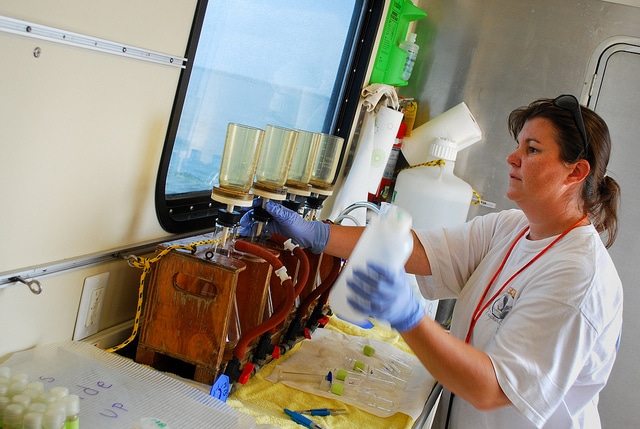Tier 3 Tidal Monitoring
Tier 3 data can be used for regulatory assessments, therefore all Tier 3 monitoring groups must demonstrate that they meet the sampling and analytical requirements of the CBP Methods and Quality Assurance procedures. This must be documented in an individual Quality Assurance Project Plan (QAPP) approved by the EPA/Chesapeake Bay Program and undergo a field audit conducted by the Chesapeake Bay Program’s Data Integrity Workgroup.
Sample Collection
Tier 3 tidal water quality monitoring groups collect discrete depth profiles using in-situ sensors or probes, and/or lab grab samples. Most programs use a combination of techniques to analyze a suite of parameters based on resources available. All equipment, technologies and sampling methods selected for this project are used to monitor baseline surface water conditions following the EPA volunteer monitoring methods for streams and estuaries. Individual groups may have more specific methods to meet specific objectives, like targeting restorations projects, tracking bacteria levels for human health, etc.
Depth profiles should take measurements from the bottom to the top of the water column. For depths >3m, samples are taken 1.0m above the bottom, then 1.0m increments up to 1.0m below the surface, Maryland monitoring groups take an additional measurement at 0.5m below the surface (ie. at a 6.4m site, measurements are taken at 5.4m, 5.0m, 4.0m, 3.0m, 2.0m, 1.0m, and 0.5m (in Maryland)). If a site is ≤3m, measurements are taken at 1.0m off the bottom and 1.0m below the surface in Virginia and 0.5m below the surface in Maryland.
Parameters
Tier 3 Tidal Monitoring projects can sample any suite of parameters that are part of the Tier 1 and 2 Tidal Monitoring program. However, must at a minimum sample the following parameters:
- water clarity (Secchi)
- dissolved oxygen (mg/l and % sat)
- water temperature (deg C)
- salinity (ppt)
Grab samples for nutrients and chlorophyll a are eligible for Tier 3 status if the samples are analyzed at a CBP approved lab and follow appropriate QA procedures. Contact us for a list of currently approved labs.

Monitoring Timeline
Each monitoring group participating has their own project timeline tailored to their specific monitoring program and data needs. Tier 3 monitoring programs typically sample weekly from May (Memorial Day) to September (Labor Day). Some groups extend their weekly monitoring season or couple weekly summer monitoring with monthly monitoring the rest of the year.
Data Use
The primary intended data user for Tier 3 data is the monitoring group collecting the data. Each monitoring group submitting data to the CMC has their own defined data use goals based on the local interests and water quality concerns.
Additionally, data are uploaded to the Chesapeake Bay Program annually. The Tier 3 data for water temperature, salinity and dissolved oxygen are being used to define aquatic habitats according to open water, deep water and deep channel designated use definitions in the bay. Designated uses underpinning Clean Water Act-supported water quality standards attainment assessments and describe the State/Tribe’s management objectives and expectations for its waters. Further, the Tier 3 data are used in combination with State-based tidal water quality monitoring program data in Maryland and Virginia to evaluate water quality conditions against applicable dissolved oxygen to assess standards attainment. Monitoring and analysis results are reported to USEPA supporting evaluation of their impairment status and the need to list a waterway as impaired or delist waters from the impaired list.
Service Providers
UMCES facilitates the process by which a group is audited by the Chesapeake Bay Program’s Data Integrity Workgroup and can provide data interpretation and visualization workshops.
If you are interested in becoming a Tier 3 monitoring group, contact your CMC service provider to get started.
